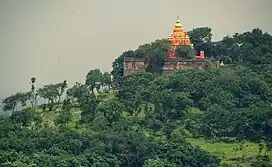Parvati Hill
Parvati Hill is a hillock in Pune, India. The hillock rises to 2,100 feet (640 m) above sea level. Atop the hillock is the Parvati Temple, one of the most scenic locations in Pune. The temple is the oldest heritage structure in Pune and was built during the rule of the Peshwa dynasty.[1] For visitors, Parvati hill is also an observation point that offers a panoramic view of Pune. It is the second highest point in Pune (after Vetal Hill). The hill has 108 steps (considered a holy number in Hinduism) leading to the top of the hill where the temple is situated.[2] The hill was owned by the Patil named Taware. Peshwa purchased the hill to build a temple of Shiva. The Devi temple was believed to be of Taware's kulswami whose angara was able to cure a leg ailment of Kashibai, mother of Peshwa Balaji Baji Rao.[3] Thereafter, the Peshwa built a temple complex there.[3]
| Parvati Hill | |
|---|---|
 Parvati Hill | |
| Highest point | |
| Elevation | 2,100 ft (640 m) |
| Coordinates | 18°29′50″N 73°50′48″E |
| Geography | |
 Parvati Hill | |
| Parent range | Western Ghats |
| Climbing | |
| Easiest route | The hill has 103 steps, which is the way to the top of the hill. |
The main temple, Devdeveshwara, is made of blackstone. It was completed under Balaji Baji Rao in 1749, and a gold pinnacle was added to the temple in 1760. Other temples are dedicated to Vitthal and Rukmini, Vishnu, and Kartikeya.[3]
Temples
Parvati Hill has 5 temples atop it:[2]
Along with other temples of Surya (the sun) and Bhawani mandir The temples open at 5:00 am and close at 10:00 pm.
Other structures
Besides the temple, the Peshwa Museum is situated there. The museum houses the weaponry, coins, utensils, wooden furniture, modes of transport (palanquin) and gifts acquired from the times of the Peshwas.[4]
The samadhi of Balaji Baji Rao is also located here, where he spent the last moment of his life.
The Parvati water tank supplies water to the half of the city of Pune.

Half way up the hill, on the south-eastern side, there is an old Buddhist cave. Though unfinished, it is believed to be contemporary with the Pataleshwar caves.
References
- "History of Parvati". Parvati Darshan. Archived from the original on 21 December 2014. Retrieved 15 January 2012.
- Menon, Anoop (22 August 2017). "Ganesh Chaturthi 2017: Famous Ganesh Temples in Pune". India.Com. Archived from the original on 22 September 2022. Retrieved 1 October 2022.
- Kulkarni, Uday S (21 January 2019). "The hill temples of the Peshwas". India Times. Archived from the original on 26 July 2021. Retrieved 1 October 2022.
- Raghu, Sunita (5 August 2018). "Peshwa's pride". New Indian Express. Archived from the original on 26 July 2021. Retrieved 1 October 2022.
